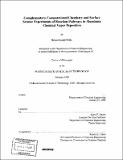| dc.contributor.advisor | Klavs F. Jensen. | en_US |
| dc.contributor.author | Willis, Brian G | en_US |
| dc.contributor.other | Massachusetts Institute of Technology. Dept. of Chemical Engineering. | en_US |
| dc.date.accessioned | 2005-08-23T18:05:10Z | |
| dc.date.available | 2005-08-23T18:05:10Z | |
| dc.date.copyright | 1999 | en_US |
| dc.date.issued | 1999 | en_US |
| dc.identifier.uri | http://hdl.handle.net/1721.1/8180 | |
| dc.description | Thesis (Ph. D.)--Massachusetts Institute of Technology, Dept. of Chemical Engineering, 1999. | en_US |
| dc.description | Includes bibliographical references. | en_US |
| dc.description.abstract | Continued advances in the semiconductor industry will require the introduction of new materials and processes concurrent with shrinking device dimensions. These simultaneous demands drastically reduce margins for error and necessitate an increasingly quantitative understanding of semiconductor processes. Leaders of the semiconductor industry have recognized these challenges and featured atomistic process modeling as one of the "Difficult Challenges" for designs below 100 nm, predicted beyond the year 2006. Among these tasks, obtaining detailed, quantitative understanding of process chemistry and physics has been identified as on of the biggest hurdles. Another "chief roadblock" is linking atomistic reaction models to reactor scale process simulations. Process modeling includes simulations of reactor transport, thin film growth, morphology, and uniformity, and device feature profile evolution (how well desired features are grown). A key ingredient to processes modeling, whether atomistic or macroscopic, is knowledge of the elementary reaction pathways and chemical intermediates, and reaction thermodynamics and kinetics. Quantum chemistry methods present power tools to investigate these molecular properties for both gas phase and surface reactions. Along with pioneering efforts in applying these tools to semiconductor processes come issues such as understanding accuracy, how to approach a given problem, and defining problems into practical sizes. To this end, a combined experimental/theoretical study of aluminum chemical vapor deposition has been performed. Both conventional ab initio and more recent density functional theory methods (DFT) have been investigated and evaluated. | en_US |
| dc.description.abstract | (cont.) Aluminum chemical vapor deposition (CVD) is a process of interest for semiconductor metalization. Aluminum has been the workhorse metal for interconnect applications since the dawning age of the semiconductor industry. Although aluminum is traditionally deposited with advanced physical vapor deposition (PVD) techniques, new deposition methods, such as CVD, are required as characteristic feature sizes move into the nanometer range. In the present study, a combined experimental/theoretical approach has been implemented to investigate both vapor phase and surface reaction pathways of the aluminum CVD precursor dimethylaluminum hydride (DMAH). DMAH is arguably the best aluminum CVD precursor available, but it has complications including a puzzling liquid and vapor phase chemistry, and an unknown surface chemistry. Detailed knowledge of the deposition process is necessary to design a robust, high yield aluminum CVD process. In the present studies, experimental observations have been taken from the literature for the vapor phase chemistry, and ultra-high vacuum (UHV) surface science studies have been employed to investigate the surface chemistry. Theoretical studies were performed by combining quantum chemistry calculations with transition state theory (TST) and micro-kinetic style estimation of rate parameters ... | en_US |
| dc.description.statementofresponsibility | by Brian Gerald Willis. | en_US |
| dc.format.extent | 214 leaves | en_US |
| dc.format.extent | 15719085 bytes | |
| dc.format.extent | 15718845 bytes | |
| dc.format.mimetype | application/pdf | |
| dc.format.mimetype | application/pdf | |
| dc.language.iso | eng | en_US |
| dc.publisher | Massachusetts Institute of Technology | en_US |
| dc.rights | M.I.T. theses are protected by copyright. They may be viewed from this source for any purpose, but reproduction or distribution in any format is prohibited without written permission. See provided URL for inquiries about permission. | en_US |
| dc.rights.uri | http://dspace.mit.edu/handle/1721.1/7582 | |
| dc.subject | Chemical Engineering. | en_US |
| dc.title | Complementary computational chemistry and surface science experiments of reaction pathways in aluminum chemical vapor deposition | en_US |
| dc.title.alternative | Complementary quantum chemistry calculations and surface science experiments of reaction pathways in aluminum chemical vapor deposition | en_US |
| dc.type | Thesis | en_US |
| dc.description.degree | Ph.D. | en_US |
| dc.contributor.department | Massachusetts Institute of Technology. Department of Chemical Engineering | |
| dc.identifier.oclc | 50046581 | en_US |

